(Simple Version) - Simplified System by the Reorganization of TRIZ Solution Generation Methods
Hideaki Kosha and Yuji Mihara (Fuji Photo Film Co., Ltd., Japan)
Editor's Note (Toru Nakagawa, Nov. 19, 2002)
This document describes the Solution Generation Methods of USIT in a simple form on the basis of our paper presented at the ETRIA World Conference held in November, 2002. As a course material for studying USIT from the beginning, the USIT methods are described with easy to follow guidelines.In order to learn the principles and usage of the whole USIT method, please refer to the following paper:
"Experiences of Teaching and Applying the Essence of TRIZ with Easier USIT Procedure", Toru Nakagawa, presented at TRIZCON2002, St. Louis, Apr. 28-30, 2002; posted here in "TRIZ Home Page in Japan", May 16, 2002.The USIT methods summarized here have been obtained by reorganizing the huge body of the solution generation methods in TRIZ (especially including Inventive Principles, Inventive Standards, and Trends of Technical Evolution) and by unifying them into an easy-to-understand hierarchical scheme. Thus the whole TRIZ know-hows are effectively applicable with the present methods to real problem solving. Pleasee refer the original paper and its appendix concerning to the theoretical basis of reorganizing TRIZ and also the full description of the USIT Solution Generation Methods:"Reorganizing TRIZ Solution Generation Methods into Simple Five in USIT", Toru Nakagawa, Hideaki Kosha and Yuji Mihara, presented at ETRIA World Conference 'TRIZ Future 2002', Strasbourg, Nov. 6-8, 2002; posted here in "TRIZ Home Page in Japan", Nov. 19, 2002.Please communicate to the Editor concerning to any experience, comments, questions, etc. on the learning and applications of the USIT method.
"USIT Solution Generation Methods", Toru Nakagawa, Hideaki Kosha and Yuji Mihara, presented as the Appendix to the above paper at ETRIA World Conference 'TRIZ Future 2002', Strasbourg, Nov. 6-8, 2002; posted here in "TRIZ Home Page in Japan", Nov. 19, 2002.
| Page Top | Contents | 1. Object Pluralization Method | 2. Attribute Dimensionality Method | 3. Function Distribution Method | 4. Solution Combination Method | 5. Solution Generalization Method | Note: Symbols |
| ETRIA2002 Paper "Reorganizing TRIZ" | TRIZCON2002 Paper "USIT" | Simple version (USIT Sol. Methods) | Full version (USIT Sol. Methods) | Extended version (USIT Sol. Methods) | Japanese page |
USIT Solution Generation Methods
USIT Solution Generation Methods (Contents. One-page Reminder) Sept. 18, 2002
| (1) Object Pluralization Method
a. Eliminate (2) Attribute Dimensionality Method a. Deactivate a harmful |
(3) Function Distribution Method
a. Reassign to a different Object (4) Solution Combination Method a. Combine functionally (5) Solution Generalization Method a. Generalize/specify |
(1) Object Pluralization Method
Operate on each Object to 'Pluralize' it. 'Plural', in the sense of English language, means any number except 1; hence, 0, 2, 3, ..., ?, 1/2, 1/3, ..., 1/?, etc. Besides, introduce a new/modified Object.
(1a) Eliminate the Object (into 0). (Simplification, Trimming)
| Eliminate the (subsidiary) Object in the system and reassign the Functions in the simplified system. | 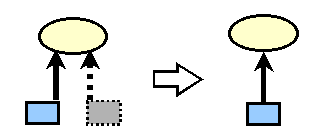 |
(1b) Multiply the Object (into 2, 3, ..., ?).
| Multiply the Object into 2, 3, ... , and infinitely many, then modify the properties of the Objects (slightly or largely), and use them together. | 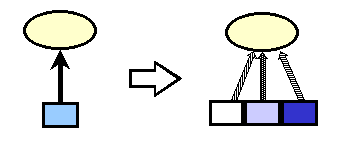 |
(1c) Divide the Object (into 1/2, 1/3, ..., 1/?).
| Divide the Object into multiple parts (1/2, 1/3, ..., 1/?), modify the parts (slightly, or differently for different parts), and combine them for using together in the system. |  |
(1d) Unify multiple Objects into one.
| Combine multiple inter-related Objects in the system and turn them into one Object with unified structure and functionality. | 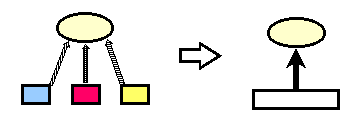 |
(1e) Introduce a new/modified Object.
| Modify the present Object in its properties or structure, or else introduce a new-type of Object having new properties and functionality, so as to achieve desirable effects and functionality. |  |
(1f) Introduce an Object from the Environment.
| Environment here means anything which is around the present system and is available easily and inexpensively. (Though this is pointed out in (1e) as the resource for obtaining an Object for modification and newly introduction, the use of the Environment is apt to be overlooked but important.) | 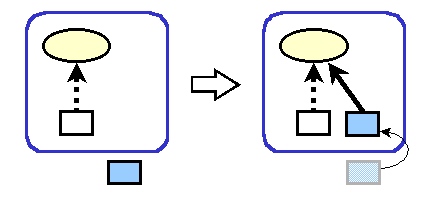 |
(1g) Replace a solid Object with a powder/fluid/liquid/gaseous Object.
| Replace a solid Object in the system with powder Object, and further with fluid/liquid/gaseous Object, which may introduce characteristic properties such as fluidity, flexibility, operability, reactivity, etc. In relation to the replacement, a different kind of substance (or material) and a different mechanism of operation are often needed. Note: This submethod (1g) may be regarded as an extension of submethod (1c) 'division of Objects', but is noted here because of the necessity of rather large change in the Object and in Functions. |
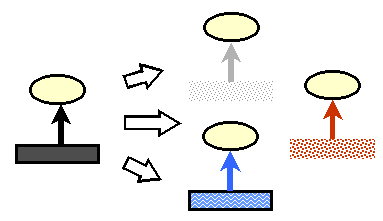 |
(2) Attribute Dimensionality Method
Each Object (or substance) has different kinds of properties (where each category of properties is called 'Attribute'); thus we consider to newly use/stop using/enhance/fully use such properties. Especially, it is important to distribute/vary useful properties in space (including the inner structure) and in time in an effective way. Improving the properties of the whole system is an important target, too.

(2a) Deactivate/make irrelevant the harmful Attribute.
| Find any harmful properties in the system, and do not use them/make them irrelevant/turn them harmless/turn them into useful properties in the system. | 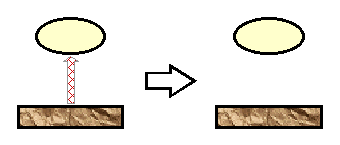 |
(2b) Activate/involve a new useful Attribute.
| In the Object present in the system, start utilizing the Attribute (properties) (which has not been used yet) or introduce a new Attribute by modifying the Object. Further, if appropriate, replace the present Object with a new Object (or material) having such a useful Atribute and introduce a new function (or Field) which make the new properties effective. There are different sorts of Attributes. Consider the following types of Attributes: | 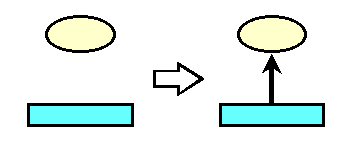 |
(2c) Enhance the useful Attribute or suppress the harmful Attribute.
| Enhance the useful but insufficient Attribute or suppress the harmful/excessive Attribute. The same kinds of Attrributes are handled as used in the previous submethod (2b). | 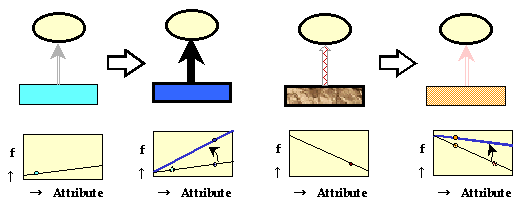 |
(2d) Introduce/enhance a spatial Attribute or distribute/vary in space a harmful/useful Attribute or Attribute's value.
| Introduce or enhance an Attribute related to the space, or activate an Attribute (or vary the Attribute's value) depending on different places in space (or different parts of an Object). | 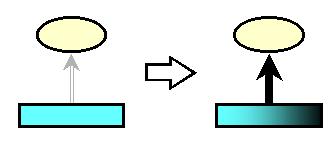 |
(2e) Introduce/enhance a temporal Attribute or distribute/vary in time a harmful/useful Attribute or Attribute's value.
| Introduce/enhance the temporal Attribute(s) related to the operational phases, duration of operations, time frequency, etc. of the system, and depending on such temporal conditions activate different Attributes or vary the values of the Attributes in time. | 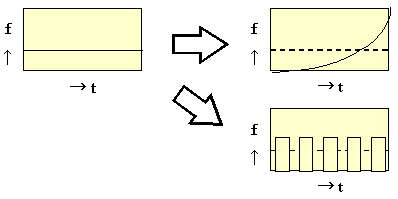 |
(2f) Change the phase, utilize the phase change, or change the inner-structure of the Object.
| Change the phase (i.e. state of condensation) of Object(s) , utilize the phase change, or introduce/change the inner structure at the micro level for using various Attributes thus activated/enhanced. | 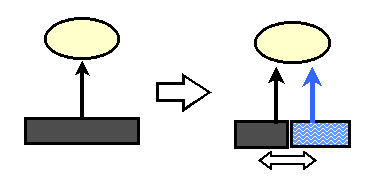 |
(2g) Utilize Attribute(s)/properties at the micro level.
| Consider/design the structure/properties/interactions of Object(s) at the micrometer or nanometer (or even smaller) scale, and solve the problem from the micro-level principles. | 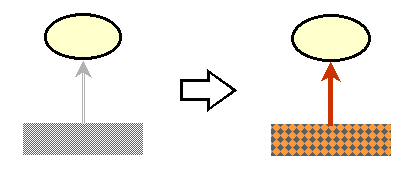 |
(2h) Improve the properties/performance of the system as a whole.
| (Besides the Attributes and Functions of the Objects as the components of the system,) consider the properties (or Attributes) and Functions of the system as a whole and improve them by designing/implementing/improving the system and its components. | 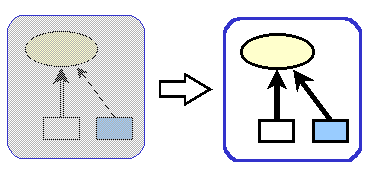 |
(3) Function Distribution Method
For the purpose of achieving/improving the principal useful Function of the system, distribute/rearrange various useful Functions (and some harmful Functions subsequently appearing) among the Objects which are already present, modified, or newly introduced into the system. Various Functions need to be transferred, divided, unified, or introduced. It is necessary to distribute/vary the Functions in a suitable way in space and in time, and further for better working of the system it is the key to utilize higher-level Functions for adapting/controlling etc.
(3a) Reassign the Function to a different Object.
| Reassign (or transfer) the present Function to a more suitable different Object which are already present or newly introduced in the system. | 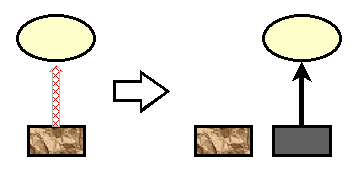 |
(3b) Divide the compound/multiple Functions and assign them to different Objects or different parts of an Object.
| Divide the compound/multiple Functions present in the system and reassign the divided Functions to different Objects (already present or newly introduced) or different parts of Objects. |
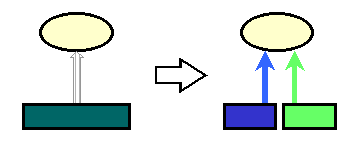 |
(3c) Unify multiple Functions and assign the unified Function to an Object.
| Unify multiple Functions of multiple Objects and assign the unified Function to one Object. | 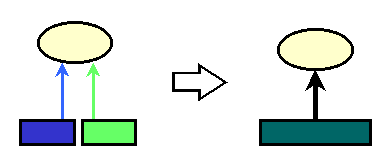 |
(3d) Introduce a new Function to assign to an Object.
| In order to achieve the target of the system or to solve the problem, introduce a new Function and assign it to an Object either present/modified or newly introduced. | 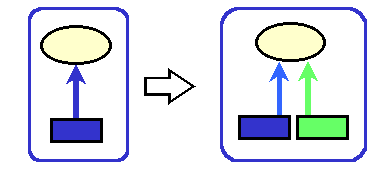 |
(3e) Distribute/vary the Function in space or utilize the spatial distribution/motion/vibration Function.
| Distribute/arrange the Function(s) in some spatial order/structure and increase the degree of spatial freedom. Utilize/enhance the spatial Function(s) of distributing/moving/vibrating the Object(s) (or the Attribute(s) of Object(s)). | 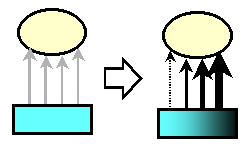 |
(3f) Distribute/vary the Function in time.
| Set the time (or timing) of operation of the Function(s) in an appropriate way. Set the timing of operation of a Function, in the sense of time period of operation (such as triggering event, operational conditions, etc.), temporal variation in the long time range, and temporal variation in the short time range (e.g., in pulses, in cycles, frequency, etc.), and also set the timing of multiple Functions in the sense of the sequential order, the relative timing of operations, etc. | 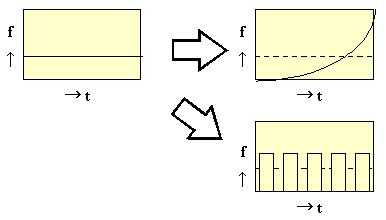 |
(3g) Realize the detection/measurement Function.
| Perform the detection/measurement Function as simply and quickly as possible (especially, make the detection/measurement itself unnecessary, if possible) and by using Attributes sensitive and accurate for detection/measurement. [See (3h) also.] | 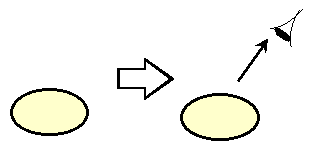 |
(3h) Introduce/enhance the adapting/coordination/control Function.
| Introduce/enhance Function(s) for adapting/coordinating/controlling the system and make the system higher and more intelligent. | 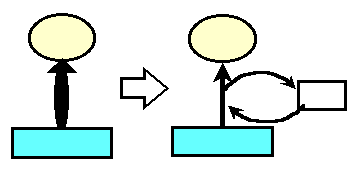 |
(3i) Achieve the Function with different physical principle.
| In place of the present Function (especially the one achieved by gravitational or mechanical principles), achieve the similar Function in a more effective and controllable way on the basis of a different physical principle. | 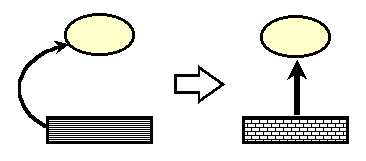 |
(4) Solution Combination Method
Combine multiple solutions (or multiple elements of solutions) in various ways (such as functionally, spatially, temporally, structurally, at the principle level, etc.) so as to form a new solution which enhances the strong points, complements the drawbacks, and overcomes the contradictions. Also solve the problem by transferring to the super-system level.
(4a) Combine solutions functionally.
| Combine multiple solutions by linking their Functions. Especially, combine multiple solutions by linking Functions which are related in causal relationships or by combining Functions which are complementary or contrary with one another. | 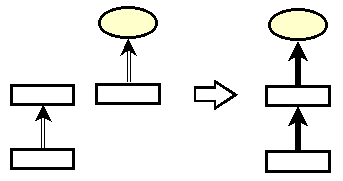 |
(4b) Combine solutions spatially.
| Combine multiple solutions in respect to the spatial positions to apply; for instance, at different places (for avoiding the mutual interferrence), at distributed places, side by side, in front and back (in sequence), on top and bottom, at the same place alternatively, inside of the other, as an inner-structure of the other, etc. | 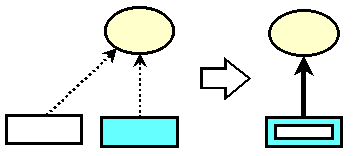 |
(4c) Combine solutions temporally.
| Combine multiple solutions in respect to time to apply; for instance, in sequence (one after another), beforehand of the other, simultaneously (in parallel), afterwards of the other, in the reverse order, alternatively, in pulses, periodically, from time to time, interrupting/switching corresponding to the situations, etc. | 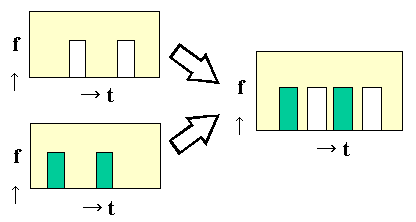 |
(4d) Combine solutions structurally.
| Combine multiple solutions by forming a (hierarchical) functional structure in such a way that the solutions are performed alternatively under different conditions or performed at different levles. | 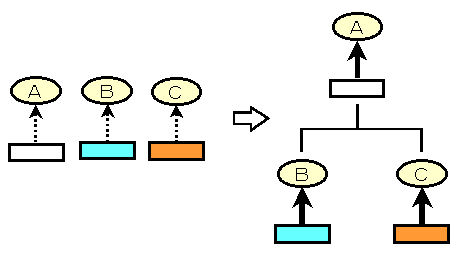 |
(4e) Combine solutions at the principle level.
| Combine multiple solutions based on different principles and form a solution in various ways; for instance, as a temporary solution in the transient stage, in a hybrid system, in a compromise, to back-up the other, to perform on a background of the other, etc. |  |
(4f) Combine solutions at the super-system level.
| Consider the higher-level purpose or principal function which should be performed by the system in the problem and solve the current problem by combining/coordinating the present system with the neighboring system(s) and forming/improving the higher-level system (i.e. the super-system). | 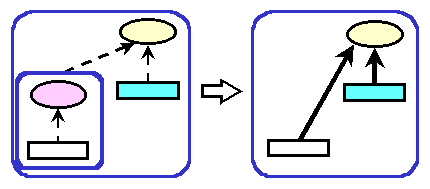 |
(5) Solution Generalization Method
Represent a solution in a more general way, form a solution template, and obtain concepts of solutions in the associative manner. Also generate a hierarchical system of solutions.
(5a) Generalize/specify the solution for associative thinking.
| Replace the technical/specific terms in a solution with plain/generic terms, form a plain solution template, and then obtain new specific conceptual solutions in an associative way. |  |
(5b) Construct a hierarchical system of solutions.
| Classify a number of solutions obtained so far, make a hierachical system of solutions with respect to the levels of generalization, consider the overall view of the solution space, and try a comprehensive search of solutions. |  |
Notes of Symbols for Illustrations:

Objects: Oval: Object, especially Target Object which is affected by the Function.
Rectangles: Objects, especially Tool Objects which act with the Function.
Attributes: Attributes are sorts (or categories, and not values) of properties of Objects.
Shown with different colors and patterns for each object.
The patterns in the above figures intend: Solid, Powder, Liquid, Gas,
Hazardous, Varying in space, and Micro-level properties of Objects..
Functions: Shown with different styles of arrows.
solid arrow: useful Function
broken-line arrow: (useful but) insufficient Function
fat arrow: excessive (and hence rather harmful) Function
crossed arrow: harmful Function
Three different patterns of arrows for showing different Functions.
Solutions: Shown with round-cornered rectangles.
| Page Top | Contents | 1. Object Pluralization Method | 2. Attribute Dimensionality Method | 3. Function Distribution Method | 4. Solution Combination Method | 5. Solution Generalization Method | Note: Symbols |
| ETRIA2002 Paper "Reorganizing TRIZ" | TRIZCON2002 Paper "USIT" | Simple version (USIT Sol. Methods) | Full version (USIT Sol. Methods) | Extended version (USIT Sol. Methods) | Japanese page |
Last updated on Apr. 3, 2003. [Note added: Dec. 22, 2012] Access point: Editor: nakagawa@ogu.ac.jp